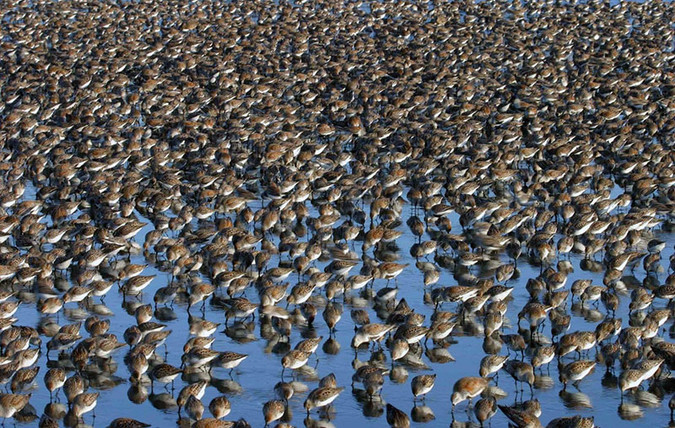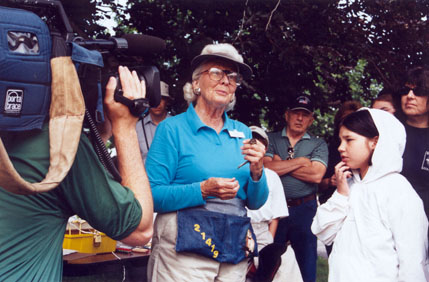The Wrack
The Wrack is the Wells Reserve blog, our collective logbook on the web.
The Wrack is the Wells Reserve blog, our collective logbook on the web.
One April long ago, my ornithology instructor took our class to Bowerman Basin to view an annual sandpiper spectacle he helped discover and document. Dr. Herman delivered us to an enormous flock of shorebirds and, as science students "seeking patterns in nature," charged us with tallying them.

"How do we count such a huge flock of birds?" we asked the sage.
"Count the legs and divide by two," was his wisdom.*
Ever since, I've strived to get good looks at bird legs whenever I've got binoculars in hand. No, I'm not counting them; I'm checking them for bands. Steve also taught us the value of studying birds as individuals and as populations — and how both approaches are aided by a scientist's ability to identify specific birds reliably. To do that requires marking them and legs are the go-to appendage.
Marking bird legs is nothing new. Romans tied thread to swallow legs more than two millenia past and a 16th century falconer known as Henry IV fastened a metal ring to at least one peregrine tarsus. But banding birds in service to rigorous scientific study really took off in the early 1900s, both in Europe and in North America. More than a million birds are now banded in our country every year.
 Most banded birds are never noted again, but my leg-gazing habit has occasionally rewarded me with an eyeful of ankle bracelet. A ruddy turnstone on a Hawai`i beach, a goldfinch at my feeder, and numerous lawn-grazing Canada geese at city parks have revealed a tiny bit of their personal histories when I've spied the bander's ring.
Most banded birds are never noted again, but my leg-gazing habit has occasionally rewarded me with an eyeful of ankle bracelet. A ruddy turnstone on a Hawai`i beach, a goldfinch at my feeder, and numerous lawn-grazing Canada geese at city parks have revealed a tiny bit of their personal histories when I've spied the bander's ring.
Urban geese are approachable and I've copied complete band numbers by standing patiently amid a flock. But songbirds and shorebirds don't stay put and their leg bands are miniscule; recognizing them at a distance calls for another approach.
Ornithologists sometimes supplement the official numbered metal band with colored plastic bands. When used in combination, these bands allow individual birds to be identified at a distance. Blue over green (left leg) / red over silver (right leg) can be just as good as 871-39655 stamped imperceptibly into a subject bird's ring.
The other day I glanced out a farmhouse window to see two bluebirds nest-site prospecting at a nearby bird box. The male carried at least two bands, its official numbered metal band and at least one colored plastic band — yellow — attached for some particular purpose. Who banded it? Where? When?
 Take a slow walk at the reserve, methodically inspecting avian ankles, and you're not unlikely to locate a bird that has encountered a bird bander's mist net and gained bling because of it. That's largely because master permittee #21419, better known as June Ficker, has been capturing birds here for years and thousands of song sparrows, gray catbirds, various warblers, and other species have had their legs encircled by her bander's pliers.
Take a slow walk at the reserve, methodically inspecting avian ankles, and you're not unlikely to locate a bird that has encountered a bird bander's mist net and gained bling because of it. That's largely because master permittee #21419, better known as June Ficker, has been capturing birds here for years and thousands of song sparrows, gray catbirds, various warblers, and other species have had their legs encircled by her bander's pliers.
June's quarter century of public bird banding demonstrations at the Wells Reserve have made her famous, so it was little surprise when Bonnie Thomas of Kennebunk sent us a picture of a color-banded red-winged blackbird in her Kennebunk yard. Could we help her figure out where it came from?
This red winged blackbird showed up in our yard a few days ago for a quick stop. It has bands on his feet so I am sending a pic along in case it is one you know of. We live in Kennebunk.
I knew this wasn't one of "June's birds" — she catches few red-winged blackbirds and doesn't put extra bands on any she does — but I figured someone in the maine-birds group might make a connection. Sure enough, within a few hours of posting my query I heard from Danny Akers, an out-of-state birder who believed the Kennebunk red-wing could be from a New York research project. A few days later Danny followed up. Bonnie's report had generated a lot of excitement in that research team:
The confidence is very high that this is one of our birds, banded near Greenwich, NY.
Things get a bit more complex from here. The color combo in the photo is Tan-Green (left leg) Dark-Silver (right leg), or TG-DS for short. We attempted to enhance the photo a bit more and it appears there is some wear and bleaching on the bands, so we are pretty confident this a bird banded in 2012.Unfortunately, that is about as far as we can get. A number of RWBL were banded at this site in 2012, some with a third color band on the left leg. Therefore, it is possible that this bird lost a third band on the left leg and we cannot know for certainty which specific bird this is and in turn, its age when banded.
As the crow flies, or in this case, the Red-winged Blackbird, the bird was relocated approximately 180 miles east of where it was banded. The line of thought is that the bird likely wintered in the mid-Atlantic, where we have had several other banded birds returned (all deceased), and then migrated up the coast. This is, by far and away, the furthest resighting or report of a live bird, from our banding project.
The thrill of a "recapture" is keen in permittees, who band hundreds or thousands of birds hoping that a few will be encountered again, thereby revealing something about the species' breeding activity, migration habits, molting pattern, or lifespan. But the excitement is at least as strong when an unsuspecting bird watcher glimpses the telltale mark of a bird scientist and, with luck, can connect that momentary observation to a bird's biography. I think Bonnie said it best: "Thank you so much for contacting me and letting me know!! This is super awesome!"
The Bird Banding Laboratory maintains a database with millions of records. The forms at reportband.gov allow you to submit metal band numbers or color markings.
* The good doctor followed up his tongue-in-cheek advice with solid training on estimating the size of large bird flocks. It's not easy, but counting out smaller groups and overlaying their occupied space repeatedly across a vast flock can result in a reasonable estimate. Practicing with partners helps.